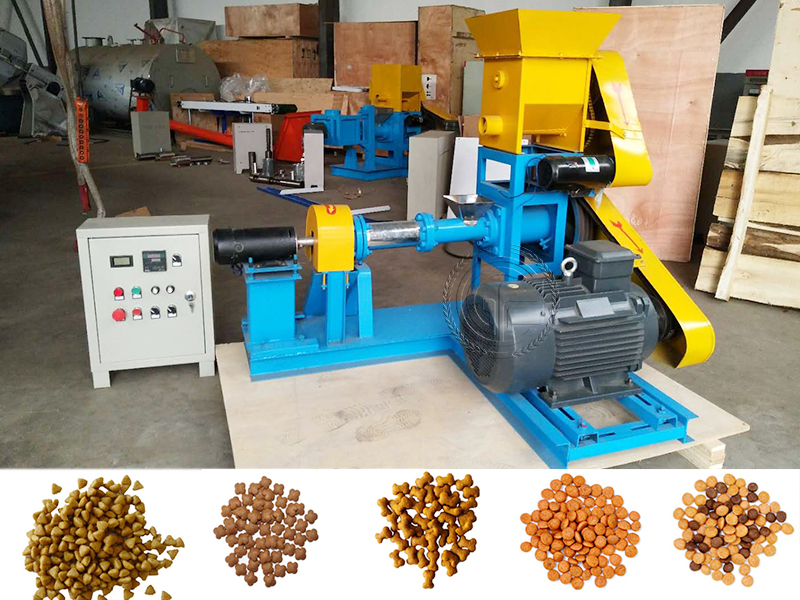Extruded Pellet Machines: The All-Round Core Equipment for Modern Feed Production
Extruded Pellet Machines: The All-Round Core Equipment for Modern Feed Production
In today’s era of rapid development in the livestock and pet food industries, extruded pellet machines, as efficient and versatile feed processing equipment, are playing an increasingly important role. This equipment not only produces high-quality pet food but is also widely used in aquatic feed, livestock feed, and other applications, becoming an indispensable core piece of equipment in the modern feed industry.
I. Extrusion Technology: A Revolutionary Breakthrough in Feed Processing
Extrusion technology, an advanced food processing method, processes raw materials under high temperature and high pressure, followed by a sudden reduction in pressure, causing the water in the raw materials to rapidly vaporize and expand, forming a granular product with a porous structure. This technology originated in 1910 and began to be used in the American pet food industry in the 1950s. It has now become a mainstream technology in feed processing.
The operating principle of an extruded pellet machine may seem simple, but it actually involves complex physical and chemical processes. Inside the extruder, the raw materials undergo multiple steps, including mixing, shearing, heating, and pressurization. Under high temperatures of 110-160°C and high pressures of 4-10 MPa, starch gelatinization and protein denaturation occur, while simultaneously killing harmful microorganisms such as Salmonella. This instantaneous high-temperature treatment not only ensures feed safety but also maximizes the nutritional value of the raw materials.
II. One Machine for Multiple Uses: Comprehensively Meeting Market Demands
The greatest advantage of an extruder lies in its wide applicability. Whether it’s producing cat food, dog food, or pet snacks in the pet food industry, floating, slow-sinking, or submerged fish feed in aquaculture, or piglet and calf feed in livestock and poultry farming, extruders are capable of producing products with varying tastes, shapes, and nutritional profiles tailored to the physiological characteristics and nutritional needs of different pets. For example, by adjusting the mold and process parameters, it’s possible to produce small-pellet cat food suitable for cats, or high-protein dog food that meets the nutritional needs of large breeds. Furthermore, the equipment supports the addition of various functional ingredients, such as probiotics and omega-3 fatty acids, to meet the personalized needs of different consumers.
In the aquatic feed industry, extruded pellet machines are indispensable. By precisely controlling the degree of extrusion, feed pellets with excellent water stability can be produced, minimizing nutrient loss and water pollution. According to statistics, high-quality extruded aquatic feed can remain stable in water for over 12 hours, and up to 37 hours, significantly improving feed utilization and aquaculture profitability.

III. Technological Innovation: Continuously Driving Industry Development
With the continuous advancement of technology, extruded pellet machine technology is also constantly innovating and improving. Modern extruders have evolved from traditional single-screw equipment to more efficient twin-screw extruders, significantly improving production efficiency and product quality. Twin-screw extruders utilize two intermeshing screws, providing enhanced mixing and shearing capabilities, enabling them to process more complex ingredient formulations. Equipped with an advanced temperature control system, these extruders typically feature 6-8 independent heating/cooling sections with a temperature control accuracy of ±1°C, ensuring the preservation of heat-sensitive nutrients. Furthermore, their modular design facilitates the replacement of screw elements and molds, enhancing production flexibility and equipment lifespan.
V. Economic Benefits: Boosting Sustainable Enterprise Development
For feed manufacturers, selecting the right extruder pellet machine not only improves product quality but also significantly enhances economic benefits. First, the equipment’s high production efficiency reduces unit production costs. Second, the extrusion process improves feed digestibility, reduces animal waste production, and lowers breeding costs. Third, high-quality extruded feed is more competitive in the market, generating higher profit margins for the manufacturer.
Market research shows that feed produced using extruder pellet machines typically commands a 10%-20% premium over traditional feed. However, due to their excellent palatability and nutritional value, they enjoy high consumer acceptance. Extruded feed also has a longer shelf life, facilitating its storage and sales.
As core equipment in the modern feed industry, extruded pellet machines, with their high efficiency, versatility, safety, and reliability, are driving the industry towards greater professionalism, intelligence, and environmental sustainability. Whether meeting the growing demand for pet food or improving the profitability of aquaculture and livestock farming, extruded pellet machines play an irreplaceable role.
Prev: The principle of feed pellet machine Next: Feed Pellet Machine Unit: A Tri-in-One Integration, Empowering Farms




